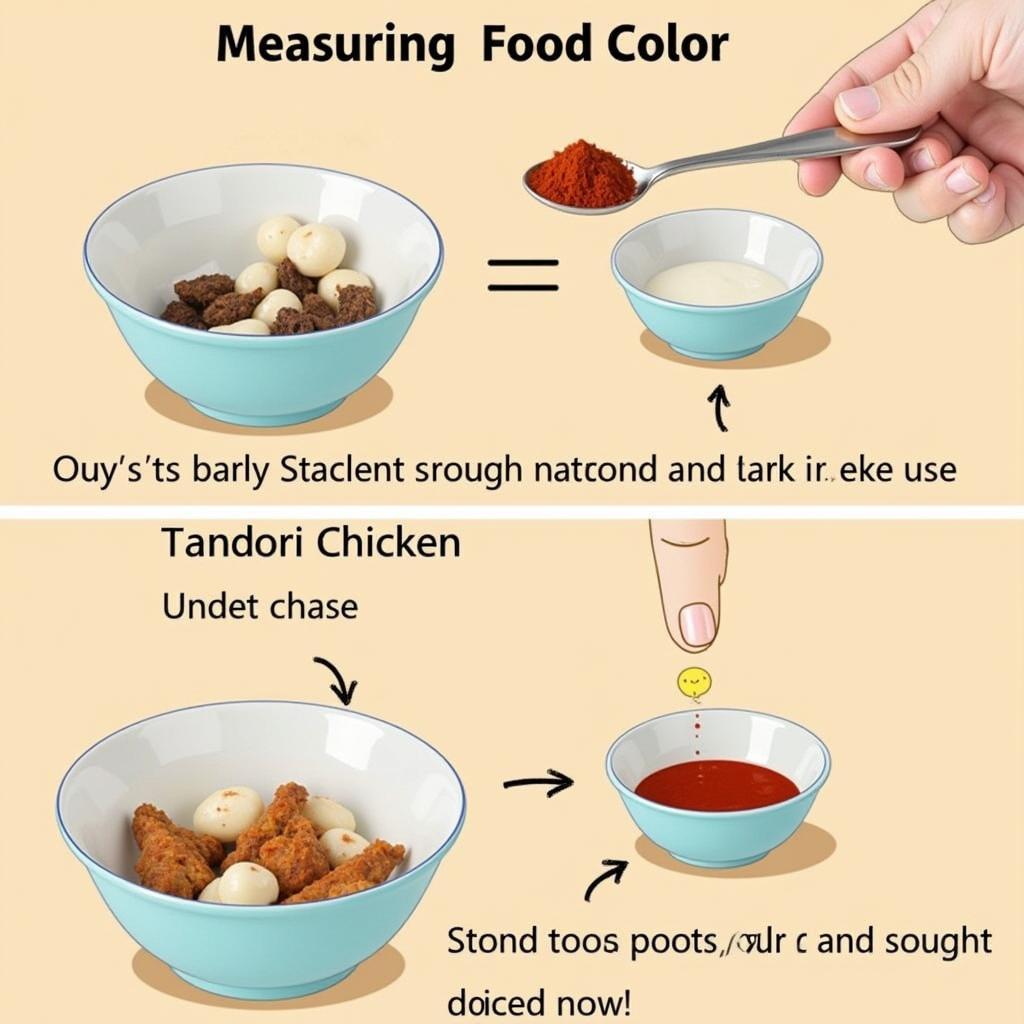Tandoori chicken’s vibrant red hue is often achieved with food coloring. But what kind of food coloring is used for tandoori chicken, and what are the alternatives? This article explores the fascinating world of Tandoori Chicken Food Coloring, delving into its history, safety, and various options for achieving that signature color.
The History and Significance of Tandoori Chicken’s Red Color
Traditionally, the reddish-orange color of tandoori chicken comes from a combination of yogurt marinade and the high heat of the tandoor oven. The yogurt helps tenderize the chicken while also contributing to the browning process. However, the intensity of the color can vary depending on the ingredients used and the cooking time. Over time, the desire for a consistently vibrant red led to the use of food coloring.
Understanding Tandoori Chicken Food Coloring
Several types of food coloring can be used for tandoori chicken. Common choices include red food coloring, both natural and artificial. Artificial red food coloring, often labeled as Red 40 or Allura Red AC, offers a vibrant, consistent color. Natural alternatives, like paprika and turmeric, can also contribute to a reddish hue, although they might not achieve the same intensity.
Navigating Natural vs. Artificial Food Coloring
Many people prefer natural food coloring options for tandoori chicken due to health concerns surrounding artificial colors. While artificial colors are generally considered safe by regulatory bodies, some individuals prefer to avoid them. Natural options offer peace of mind and can contribute their own unique flavors.
What Food Coloring is Traditionally Used in Tandoori Chicken?
Traditionally, Kashmiri chili powder was a primary source of color for tandoori chicken. This chili powder adds a deep red color and a mild heat, contributing significantly to the dish’s signature flavor profile.
Achieving the Perfect Tandoori Chicken Color at Home
Achieving that perfect tandoori red at home requires a bit of experimentation. Whether using natural or artificial coloring, start with a small amount and gradually add more until the desired color is reached. Remember, the color will deepen during cooking.
How Much Food Coloring Should I Use for Tandoori Chicken?
The amount of food coloring to use depends on the type of coloring and the desired intensity. Start with a small amount, such as 1/4 teaspoon, and gradually add more until the desired shade is reached. It’s always better to start with less and add more, as it’s difficult to remove excess color.
 Measuring Tandoori Chicken Food Coloring
Measuring Tandoori Chicken Food Coloring
Food Safety and Tandoori Chicken Food Coloring
When using any food coloring, it’s crucial to follow safety guidelines. Use food-grade coloring specifically designed for culinary purposes. Always check the expiration date and store the coloring properly.
Is Food Coloring in Tandoori Chicken Safe?
When used in moderation, food-grade coloring, whether natural or artificial, is generally considered safe for consumption. It’s always best to choose reputable brands and follow recommended usage guidelines.
Beyond the Basics: Enhancing Tandoori Chicken Flavor
While color is important, the true magic of tandoori chicken lies in its flavor. A rich marinade with yogurt, spices, and ginger-garlic paste is essential. Marinating the chicken for several hours, or even overnight, allows the flavors to penetrate deeply.
“The key to exceptional tandoori chicken is not just the color, but the balance of spices and the marination process. Don’t be afraid to experiment with different flavor combinations to create your own signature recipe,” advises renowned chef, Anya Sharma.
“Using natural food coloring, like paprika and turmeric, not only contributes to the beautiful red color but also adds complex flavor dimensions to the dish,” notes culinary historian, Dr. Vikram Patel.
Conclusion: Mastering Tandoori Chicken Food Coloring
Understanding tandoori chicken food coloring allows you to control the color and tailor the dish to your preferences. Whether you choose natural or artificial coloring, remember that flavor is paramount. By following these tips, you can create delicious, vibrant tandoori chicken that will impress your family and friends.
FAQs:
- What is the most common tandoori chicken food coloring? Red food coloring (both artificial and natural).
- Can I make tandoori chicken without food coloring? Yes, the traditional method relies on yogurt and the tandoor oven for color.
- Is artificial food coloring in tandoori chicken safe? Yes, when used in moderation, it’s generally considered safe.
- What natural food coloring can I use for tandoori chicken? Paprika, turmeric, and Kashmiri chili powder are good options.
- How can I achieve a vibrant red color with natural food coloring? Use a generous amount of Kashmiri chili powder in the marinade.
- How long should I marinate tandoori chicken? At least 4 hours, or preferably overnight, for the best flavor.
- What are some other spices commonly used in tandoori chicken? Garam masala, cumin, coriander, and ginger-garlic paste.
Other articles you might find interesting on our website include “The Art of Marinating Tandoori Chicken” and “Exploring Different Tandoor Oven Techniques”.
Need help? Contact us at Phone Number: 02437655121, Email: minacones@gmail.com Or visit our address: 3PGH+8R9, ĐT70A, thôn Trung, Bắc Từ Liêm, Hà Nội, Việt Nam. We have a 24/7 customer service team.